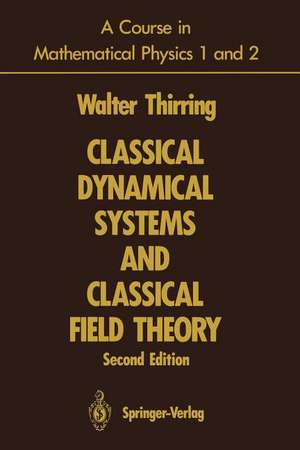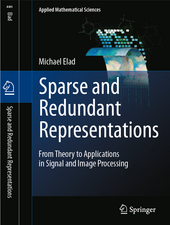A Course in Mathematical Physics 1 and 2: Classical Dynamical Systems and Classical Field Theory: Springer Study Edition
Autor Walter Thirring Traducere de E.M. Harrellen Limba Engleză Paperback – 20 dec 1991
Din seria Springer Study Edition
-
 Preț: 386.24 lei
Preț: 386.24 lei -
 Preț: 370.79 lei
Preț: 370.79 lei -
 Preț: 296.06 lei
Preț: 296.06 lei -
 Preț: 403.37 lei
Preț: 403.37 lei -
 Preț: 508.91 lei
Preț: 508.91 lei - 23%
 Preț: 871.55 lei
Preț: 871.55 lei -
 Preț: 403.37 lei
Preț: 403.37 lei -
 Preț: 389.70 lei
Preț: 389.70 lei - 15%
 Preț: 502.73 lei
Preț: 502.73 lei -
 Preț: 389.70 lei
Preț: 389.70 lei - 5%
 Preț: 1122.94 lei
Preț: 1122.94 lei - 5%
 Preț: 370.38 lei
Preț: 370.38 lei -
 Preț: 406.25 lei
Preț: 406.25 lei - 15%
 Preț: 530.58 lei
Preț: 530.58 lei -
 Preț: 398.35 lei
Preț: 398.35 lei - 5%
 Preț: 368.73 lei
Preț: 368.73 lei - 15%
 Preț: 633.02 lei
Preț: 633.02 lei -
 Preț: 392.75 lei
Preț: 392.75 lei - 15%
 Preț: 588.69 lei
Preț: 588.69 lei - 20%
 Preț: 660.99 lei
Preț: 660.99 lei - 20%
 Preț: 663.61 lei
Preț: 663.61 lei - 15%
 Preț: 640.88 lei
Preț: 640.88 lei - 15%
 Preț: 654.43 lei
Preț: 654.43 lei -
 Preț: 390.46 lei
Preț: 390.46 lei -
 Preț: 394.87 lei
Preț: 394.87 lei - 15%
 Preț: 642.03 lei
Preț: 642.03 lei - 15%
 Preț: 688.99 lei
Preț: 688.99 lei - 15%
 Preț: 642.36 lei
Preț: 642.36 lei - 15%
 Preț: 635.15 lei
Preț: 635.15 lei -
 Preț: 396.62 lei
Preț: 396.62 lei - 18%
 Preț: 893.21 lei
Preț: 893.21 lei -
 Preț: 419.14 lei
Preț: 419.14 lei -
 Preț: 423.34 lei
Preț: 423.34 lei - 20%
 Preț: 377.27 lei
Preț: 377.27 lei - 18%
 Preț: 742.97 lei
Preț: 742.97 lei - 15%
 Preț: 655.27 lei
Preț: 655.27 lei - 20%
 Preț: 336.02 lei
Preț: 336.02 lei -
 Preț: 397.38 lei
Preț: 397.38 lei
Preț: 652.81 lei
Preț vechi: 768.01 lei
-15% Nou
Puncte Express: 979
Preț estimativ în valută:
124.93€ • 129.69$ • 104.17£
124.93€ • 129.69$ • 104.17£
Carte tipărită la comandă
Livrare economică 22 martie-05 aprilie
Preluare comenzi: 021 569.72.76
Specificații
ISBN-13: 9780387976099
ISBN-10: 0387976094
Pagini: 261
Ilustrații: XX, 261 p.
Dimensiuni: 152 x 229 x 30 mm
Greutate: 0.76 kg
Ediția:Softcover reprint of the original 2nd ed. 1992
Editura: Springer
Colecția Springer
Seria Springer Study Edition
Locul publicării:New York, NY, United States
ISBN-10: 0387976094
Pagini: 261
Ilustrații: XX, 261 p.
Dimensiuni: 152 x 229 x 30 mm
Greutate: 0.76 kg
Ediția:Softcover reprint of the original 2nd ed. 1992
Editura: Springer
Colecția Springer
Seria Springer Study Edition
Locul publicării:New York, NY, United States
Public țintă
ResearchCuprins
1 Introduction.- 1.1 Equations of Motion.- 1.2 The Mathematical Language.- 1.3 The Physical Interpretation.- 2 Analysis on Manifolds.- 2.1 Manifolds.- 2.2 Tangent Spaces.- 2.3 Flows.- 2.4 Tensors.- 2.5 Differentiation.- 2.6 Integrals.- 3 Hamiltonian Systems.- 3.1 Canonical Transformations g.- 3.2 Hamilton’s Equations.- 3.3 Constants of Motion.- 3.4 The Limit t ? I ± ?.- 3.5 Perturbation Theory: Preliminaries.- 3.6 Perturbation Theory: The Iteration.- 4 Nonrelativistic Motion.- 4.1 Free Particles.- 4.2 The Two-Body Problem.- 4.3 The Problem of Two Centers of Force.- 4.4 The Restricted Three-Body Problem.- 4.5 The N-body Problem.- 5 Relativistic Motion.- 5.1 The Hamiltonian Formulation of the Electrodynamic Equations of Motions.- 5.2 The Constant Field.- 5.3 The Coulomb Field.- 5.4 The Betatron.- 5.5 The Traveling Plane Disturbance.- 5.6 Relativistic Motion in a Gravitational Field.- 5.7 Motion in the Schwarzschild Field.- 5.8 Motion in a Gravitational Plane Wave.- 6 The Structure of Space and Time.- 6.1 The Homogeneous Universe.- 6.2 The Isotropic Universe.- 6.3 Me according to Galileo.- 6.4 Me as Minkowski Space.- 6.5 Me as a Pseudo-Riemannian Space.- 1. Introduction.- 1.1 Physical Aspects of Field Dynamics.- 1.2 The Mathematical Formalism.- 1.3 Maxwell’s and Einstein’s Equations.- 2. The Electromagnetic Field of a Known Charge Distribution.- 2.1 The Stationary-Action Principle and Conservation Theorems.- 2.2 The General Solution.- 2.3 The Field of a Point Charge.- 2.4 Radiative Reaction.- 3. The Field in the Presence of Conductors.- 3.1 The Superconductor.- 3.2 The Half-Space, the Wave-Guide, and the Resonant Cavity.- 3.3 Diffraction at a Wedge.- 3.4 Diffraction at a Cylinder.- 4. Gravitation.- 4.1 Covariant Differentiation and the Curvature of Space.- 4.2Gauge Theories and Gravitation.- 4.3 Maximally Symmetric Spaces.- 4.4 Spaces with Maximally Symmetric Submanifolds.- 4.5 The Life and Death of Stars.- 4.6 The Existence of Singularities.












